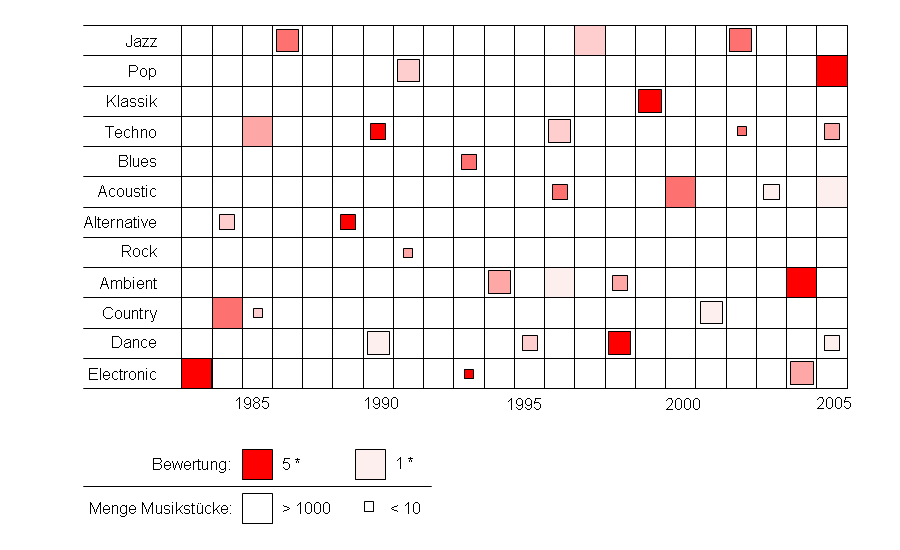Teaching:TUW - UE InfoVis WS 2005/06 - Gruppe 10 - Aufgabe 3 - Design: Difference between revisions
| Line 115: | Line 115: | ||
The visualisation is mainly meant for people collecting mp3s or for musicians who like to see some nice information they won't find in the usual representations. Moreover it's for people who like to explore their music collection under different standpoints. This will fit the exploring character of information visualisation. | The visualisation is mainly meant for people collecting mp3s or for musicians who like to see some nice information they won't find in the usual representations. Moreover it's for people who like to explore their music collection under different standpoints. This will fit the exploring character of information visualisation. | ||
Our visualisation tool will make it possible to browse through the music collection in different ways than what iTunes offers. It's meant for people who want to find some music, they for example didn't listen to for a long time. They will see from wich period the songs are, which genre they fall into and how they have been rated. This is a different starting point than usual and will allow the user to probably find other music, than without the tool. | |||
=== What are the special interests of our target group? === | === What are the special interests of our target group? === | ||
Revision as of 17:01, 20 November 2005
Application Area and given Dataset
Application Area Analysis
The application area for this task is to visualize a music archive with the data provided by ID3/iTunes tags. These tags include information about songname, artist, year, album,... The challenge in visualizing this information is to select "good" attributes that can be brought into relation, because of the high number of discreet attributes.
Dataset Analysis
| Attribute | Data type | Description |
|---|---|---|
| Name | Discreet | Song title |
| Artist | Discreet | Artist name |
| Album | Discreet | Album name |
| Genre | Nominal | Genre the song belongs to |
| Composer | Discreet | The composer of the song |
| Size | Ordinal | The file size |
| Total time | Ordinal | The total time of the song |
| Disc number | Ordinal | Number of the disc |
| Disc count | Ordinal | ... |
| Track number | Ordinal | Track number of this song on the disc |
| Track count | Ordinal | Total number of tracks on the disc |
| Year | Ordinal | Year of origin |
| Date Modified | Ordinal | Date of modification |
| Date added | Ordinal | Date when song was added to archive |
| Bit rate | Ordinal | Bit rate of song (e.g. 128kbit/s) |
| Sample rate | Ordinal | Sample rate of song (e.g. 44100Hz) |
| Play count | Ordinal | Number of time the song was played |
| Play date | Ordinal | Date of last play |
| Play date UTC | Ordinal | Date of last play in UTC |
| Location | Discreet | File location |
| File Folder Count | Ordinal | Number of file in the same folder as the current song |
| Library folder count | Ordinal | Number of files in library folder |
| Kind | Nominal | Kind of file (e.g. MPEG audio file) |
| Rating | Ordinal | Personal rating (1-5 stars) |
Target Group Analysis
Who should use this visualation technique?
The visualisation is mainly meant for people collecting mp3s or for musicians who like to see some nice information they won't find in the usual representations. Moreover it's for people who like to explore their music collection under different standpoints. This will fit the exploring character of information visualisation.
Our visualisation tool will make it possible to browse through the music collection in different ways than what iTunes offers. It's meant for people who want to find some music, they for example didn't listen to for a long time. They will see from wich period the songs are, which genre they fall into and how they have been rated. This is a different starting point than usual and will allow the user to probably find other music, than without the tool.
What are the special interests of our target group?
I think our target group is quite young, probably creative and I suppose they have some sort of interest in playing around with things a bit. As we are analysing iTunes the target group likes nice and neat design, cool tools, cool features and gimmicks. They should use the visualisation mainly for playing around with their music collection.
Are there any known / often used Methods / Visualisationtechniques?
Purpose of the Visualisation
What should be achieved with the Visualisation?
Which tasks should be solved?
Warum haben wir nur wenige Datensätze heraus genommen?
Questions that can be solved using this Visualisation
Designproposal
Which kinds of Visualisation should be used?
Visual Mapping
Used Techniques / Applied Principles
Interaction
Mockup(s) / Fake Screenshot(s)
